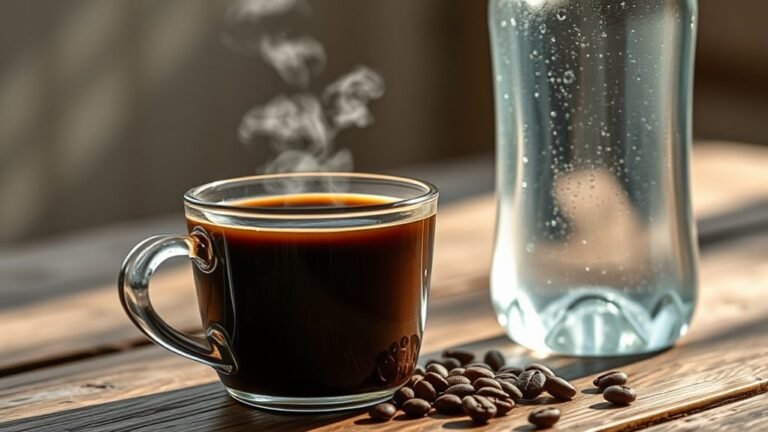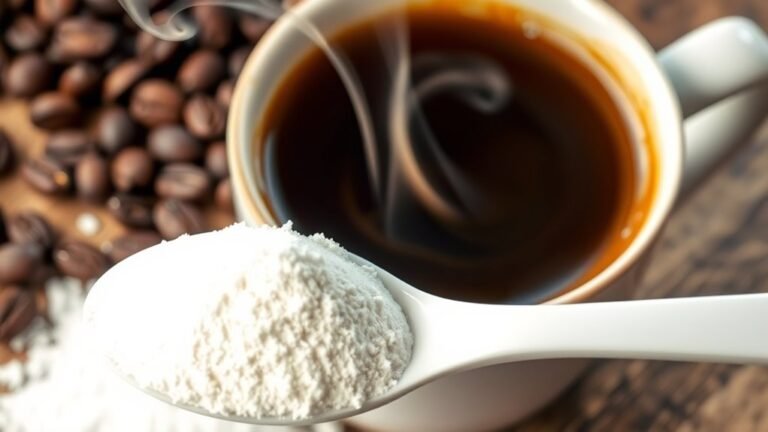Can I Use Regular Coffee in an Espresso Machine
Yes, you can use regular coffee in an espresso machine, but you’ll need to make some adjustments. Opt for a finer grind than typical for drip coffee to improve flavor extraction. Medium roasts or blends often work best, balancing acidity and richness. Pay attention to brewing temperature and pressure for ideal results. While you can achieve decent outcomes, you may notice differences in flavor profiles compared to traditional espresso. There are more tips to enhance your experience ahead.
Understanding Espresso and Regular Coffee

While many people enjoy both espresso and regular coffee, understanding their fundamental differences is essential for anyone considering using regular coffee in an espresso machine. Espresso is defined by its unique extraction process, which involves forcing hot water through finely-ground coffee under pressure. This results in a concentrated shot with rich flavor and crema. On the other hand, regular coffee encompasses various brewing methods, typically using coarser grounds and longer extraction times. The coffee types you choose can greatly impact the outcome when attempting to use regular coffee in an espresso machine. If you opt for regular coffee, you might not achieve the same depth of flavor or texture associated with traditional espresso, limiting your experience.
The Difference in Grind Size
Grind size plays an essential role in the brewing process, especially when using an espresso machine. The ideal grind consistency for espresso is fine, allowing for the quick extraction of flavors and aromas within a short extraction time. If you use regular coffee, which typically has a coarser grind, you might encounter under-extraction, resulting in a weak or sour taste. Conversely, a grind that’s too fine can lead to over-extraction, making your espresso bitter. Finding the right balance is vital for achieving that rich, full-bodied shot you seek. So, if you’re considering using regular coffee, be mindful of adjusting the grind size to suit your espresso machine’s requirements and enhance your overall coffee experience.
Roast Levels and Their Impact
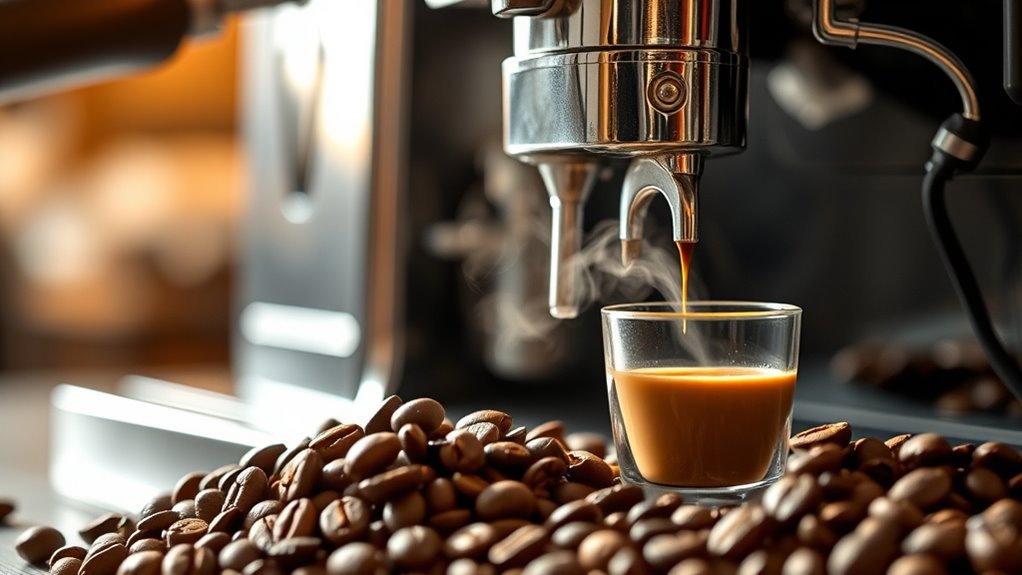
Roast levels greatly influence the flavor profile and overall experience of your espresso, especially when using regular coffee beans. Light roasts tend to offer bright, acidic flavors with floral and fruity notes, which can create a unique and invigorating espresso. However, these characteristics may not stand up under the intense pressure of an espresso machine, leading to a less balanced shot. On the other hand, dark roasts produce richer, bolder flavors, often with chocolate or smoky undertones, making them more compatible with espresso brewing. The oils released from a dark roast can enhance crema, providing a fuller mouthfeel. Ultimately, your choice between light and dark roast will considerably impact the taste and quality of your espresso experience.
Brewing Pressure and Temperature
When brewing espresso, both pressure and temperature play essential roles in extracting the coffee’s flavors and aromas. Ideally, an espresso machine operates at a pressure of around 9 bars, which helps achieve ideal extraction efficiency. If you use regular coffee, you might not get the same results, as its grind size and density differ from espresso beans. The brewing temperature typically hovers between 190°F to 205°F, ensuring that the water extracts the nuanced flavors effectively. If your brewing techniques aren’t calibrated for these conditions, you may end up with a subpar shot. Therefore, understanding how pressure and temperature interact is fundamental for maximizing extraction efficiency, whether you’re using traditional espresso beans or regular coffee.
Flavor Profiles: What to Expect
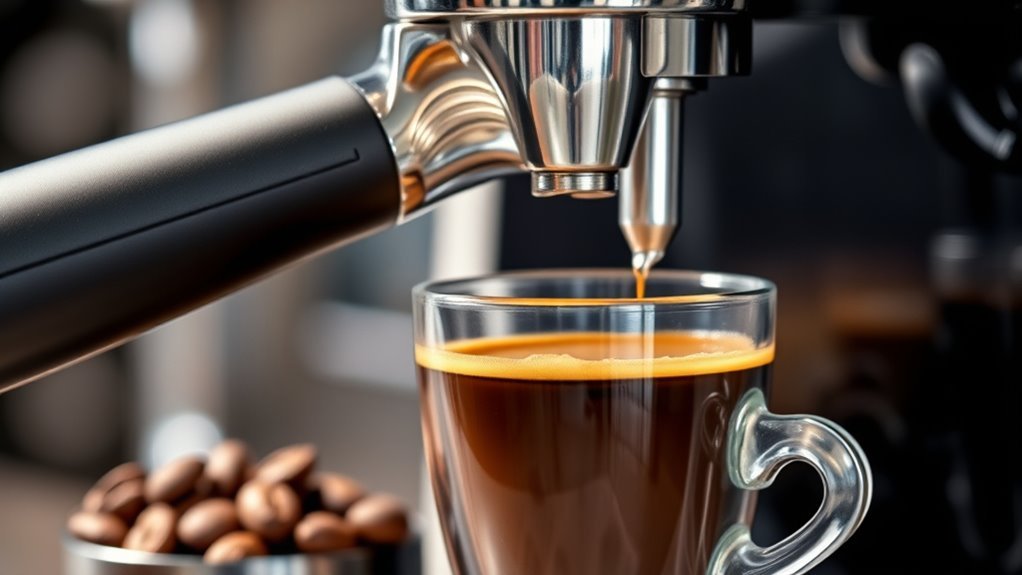
Using regular coffee in an espresso machine can lead to unexpected flavor profiles that differ considerably from what one might experience with traditional espresso beans. You’ll likely notice a shift in flavor complexity; regular coffee often lacks the deep, rich notes characteristic of espresso. Instead, you might encounter brighter, more acidic flavors, which can be invigorating but may not provide the balanced experience you desire. Aroma intensity also tends to vary; while espresso beans are roasted for maximum aroma, regular coffee may not deliver the same aromatic punch. This could result in a less engaging sensory experience. In short, while using regular coffee can be liberating, be prepared for a different taste journey that may not satisfy the usual espresso cravings.
Adjusting Brew Time for Regular Coffee
Adjusting brew time becomes essential for achieving ideal flavor when you’re using regular coffee in an espresso machine. Since regular coffee grounds can differ considerably from espresso, fine-tuning the brew time is vital to achieve the right extraction balance. If your coffee tastes bitter, you might need to shorten the brew time; if it’s too sour, try extending it.
| Brew Time (Seconds) | Flavor Profile |
|---|---|
| 20-25 | Balanced, Rich |
| 25-30 | Slightly Bitter |
| 30+ | Over-Extracted, Sour |
Experiment with these time frames to find what suits your palate best. Remember, the goal is to enhance flavors while avoiding undesirable tastes.
Tips for Using Regular Coffee in an Espresso Machine
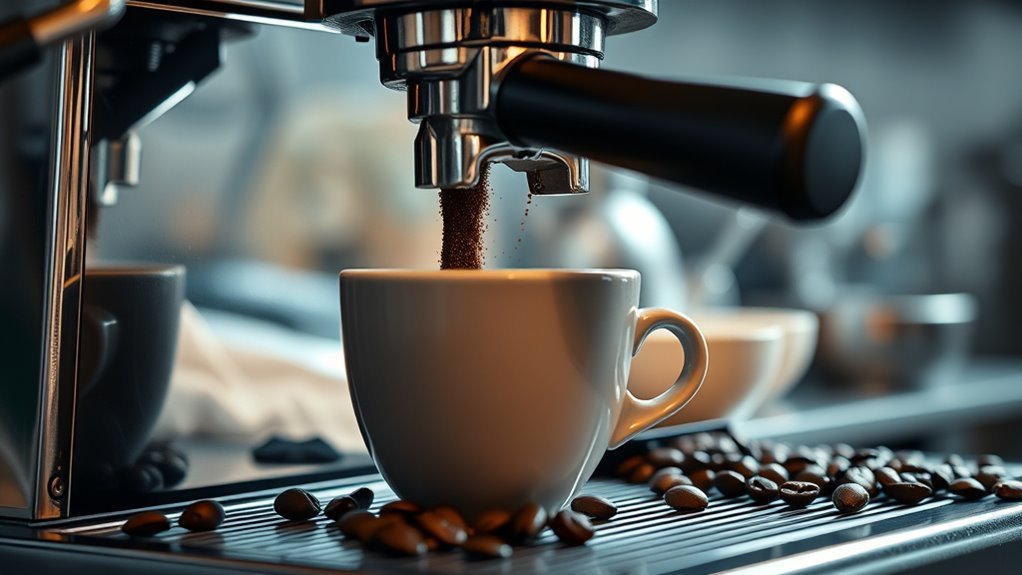
Although many espresso machines are designed for finely ground coffee, you can successfully use regular coffee by applying a few key techniques. Here are some tips to enhance your brewing experience:
Many espresso machines are versatile enough to brew regular coffee; with the right techniques, you can achieve great results.
- Choose the Right Coffee Varieties: Opt for medium roast or blends that can complement the espresso profile.
- Adjust Grind Size: Use a finer grind than you typically would for drip coffee to help achieve better extraction.
- Experiment with Brewing Techniques: Try varying the brew time and pressure to find what works best for your regular coffee.
- Monitor Water Temperature: Confirm your water is between 195°F and 205°F for ideal extraction.
Alternatives to Using Regular Coffee
When considering alternatives to using regular coffee in your espresso machine, several options can enhance your brewing experience. You might explore alternatives like specialty blends, dark roasts, or even coffee substitutes that can offer unique flavor enhancements. Each choice requires different brewing techniques to optimize your espresso.
| Alternative | Flavor Profile |
|---|---|
| Specialty Blends | Complex, varied notes |
| Dark Roasts | Bold, rich flavors |
| Coffee Substitutes | Nutty, herbal tones |
Frequently Asked Questions
Can I Use Flavored Regular Coffee in an Espresso Machine?
You can use flavored regular coffee in an espresso machine, but it might not yield the best results. The brewing techniques of espresso require a specific grind and consistency, which flavored options often lack. Additionally, the oils from flavored coffee can clog your machine over time. If you’re set on using flavored coffee, make sure it’s finely ground and clean your machine regularly to maintain peak performance. Enjoy your unique espresso creations responsibly!
Will Regular Coffee Harm My Espresso Machine?
Regular coffee won’t harm your espresso machine directly, but it could lead to maintenance issues. Notably, a study found that 70% of espresso enthusiasts prefer specific grind sizes for ideal extraction. Using a coarser grind from regular coffee might clog the machine, affecting performance. To maintain your espresso machine effectively, it’s essential to use the right grind size. If you prioritize freedom in your coffee experience, sticking to espresso beans is advisable.
How Much Regular Coffee Should I Use per Shot?
When making espresso with regular coffee, aim for about 18-20 grams per shot. The grind size is vital; it should be fine, similar to table salt, to guarantee proper extraction. An ideal extraction time is between 25-30 seconds. If the coffee’s too coarse, you’ll end up with a weak shot; if it’s too fine, it can become bitter. Adjusting these factors gives you the freedom to explore different flavors and strengths in your espresso.
Can I Mix Regular Coffee With Espresso?
Certainly, you can blend! Balancing the boldness of espresso flavor with the uniqueness of regular coffee can create enchanting coffee blends. Mixing them allows you to personalize your brew, enhancing richness while experimenting with different taste profiles. However, keep in mind that the resulting beverage may diverge from traditional espresso’s intensity. So, if you’re seeking freedom in flavor, combining regular coffee with espresso can yield delightful diversity in your cup!
Is There a Best Time to Brew Regular Coffee in an Espresso Machine?
When it comes to brewing regular coffee in an espresso machine, timing can enhance your results. Ideally, you should brew your coffee shortly after grinding to preserve its freshness. Experiment with different brewing techniques, as the grind size plays an essential role in extraction. A medium grind can work well, but you might need to adjust based on your machine’s pressure. Ultimately, finding your perfect balance allows for a richer, more satisfying cup.



